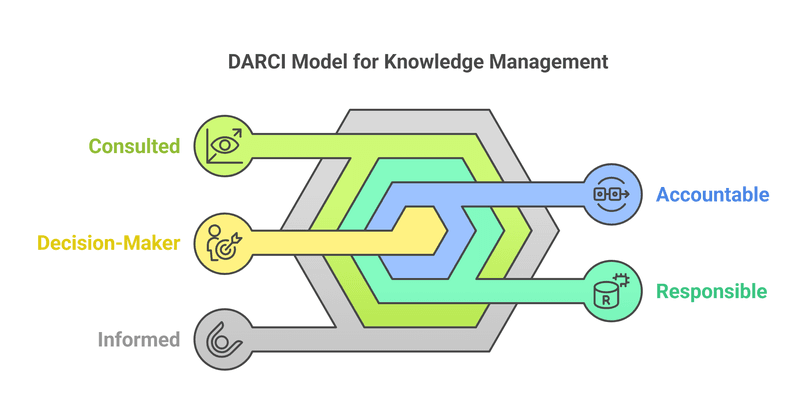Introduction
Small and medium enterprises (SMEs) often struggle with fragmented data and redundant efforts, hindering growth and innovation. The DARCI model offers a solution by providing clear role definitions to maximize knowledge management performance in SMEs. This article explores how to leverage DARCI to create clarity of responsibility and transparency across processes, paving the way for success.
The Role of Knowledge Management
The DARCI model defines five essential roles for effective knowledge management:
- Decision-Maker (D): Establishes strategic prioritiesExample: Executive team decides on knowledge tools to use
- Accountable (A): Responsible for overall success of knowledge managementExample: Knowledge manager oversees the entire process
- Responsible (R): Carries out day-to-day tasksExample: Team members document standard procedures
- Consulted (C): Provides advice and feedbackExample: Internal or external advisors offer insights
- Informed (I): Kept regularly updated on progressExample: All staff members informed when new knowledge is added

These clear role definitions prevent overlap, hold people accountable, and enable sound decision-making and efficient resource use.
DARCI: Integration into Daily Knowledge Management
DARCI transforms ad hoc information sharing into structured processes, offering key benefits:
BenefitDescriptionStandardizationSet repeatable processes for learning and knowledge sharingAvoiding DuplicationClear role assignment prevents redundant tasksEnhancing TransparencyEveryone knows who does what, establishing trust and collaboration
Practical Example: A medium-sized manufacturing firm implements an internal knowledge database:
- Executive team (D) chooses a cloud-based platform
- Dedicated knowledge manager (A) oversees the project
- Production supervisors (R) regularly update safety protocols
- Technical experts (C) peer-review critical content
- All employees (I) receive monthly update emails
Steps to Implement in Real Life
- Create a DARCI TemplateRecord knowledge tasks with columns for D, A, R, C, and I
Use the template at the start of every knowledge project - Use DARCI in TrainingProvide short training sessions on the DARCI model
Encourage questions and discussions to develop awareness - Connect DARCI with Current ResourcesIntegrate DARCI into existing knowledge management systems
Update intranet pages and manuals to specify roles - Use Process DocumentationTrack each step in knowledge sharing
Share updates using wikis or flowcharts - Periodic Review and UpdatesConduct weekly review meetings to analyze the DARCI template
Refresh roles and responsibilities as needed

Overcoming Common Challenges
ChallengeSolutionResistance to ChangeInvolve multiple people and share short success storiesLack of OwnershipClearly define and assign the Accountable role, follow up regularlyKnowledge Base ManagementUse standardized documentation templates and conduct regular content audits
Long-Term Benefits and Future Trends
Adopting DARCI secures long-term benefits for SMEs:
- Enhanced efficiency through clear collaboration and task prioritization
- Reduced knowledge loss by documenting explicit and tacit knowledge
- Improved culture of continuous learning and improvement
Recent research shows that structured processes and clear role assignments prevent knowledge loss and fuel continuous improvement. The DARCI framework can be complemented by digital collaboration tools, cloud-based storage, and automated process audits, enhancing SMEs' competitiveness and decision-making capabilities.
Final Thoughts and Personal Reflection
Organizations that capture and leverage their knowledge are better equipped to succeed in today's fast-changing market. The DARCI model provides the structure needed to ignite change, power daily operations, and cultivate a culture of continuous learning. By matching roles to knowledge management responsibilities, SMEs can transform isolated information into a valuable business asset.
Call-to-Action
- How are you currently managing knowledge in your SME?
- Have you implemented a structured model such as DARCI?
- Share your experience and how clearer role definitions have helped or could help your organization.
#KnowledgeManagement #DARCI #SMELeadership #OrganizationalEfficiency #ContinuousImprovement
